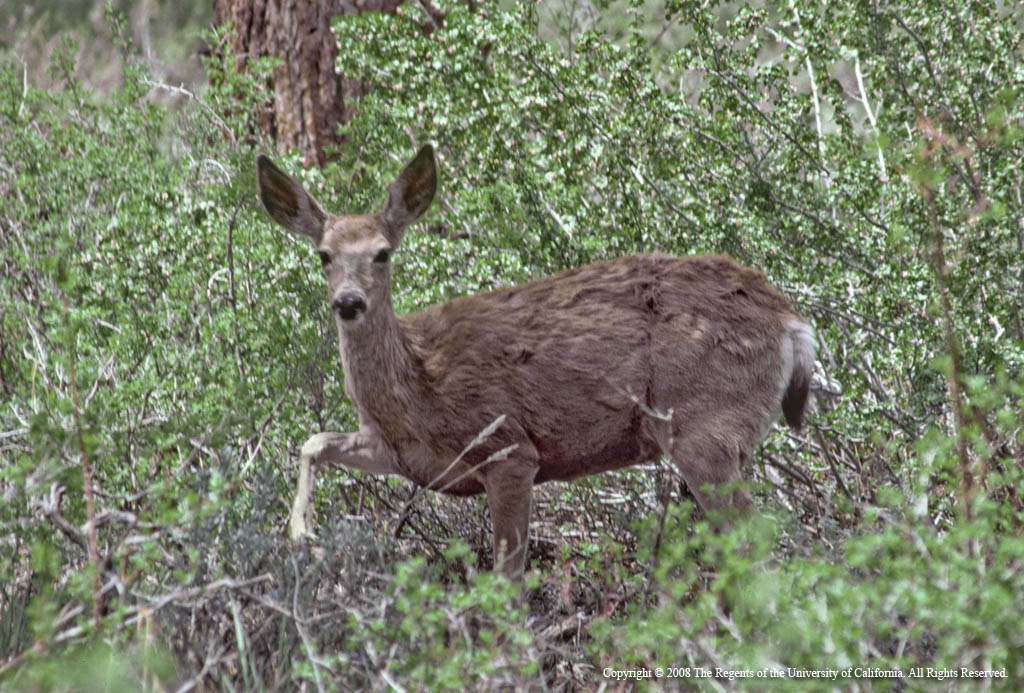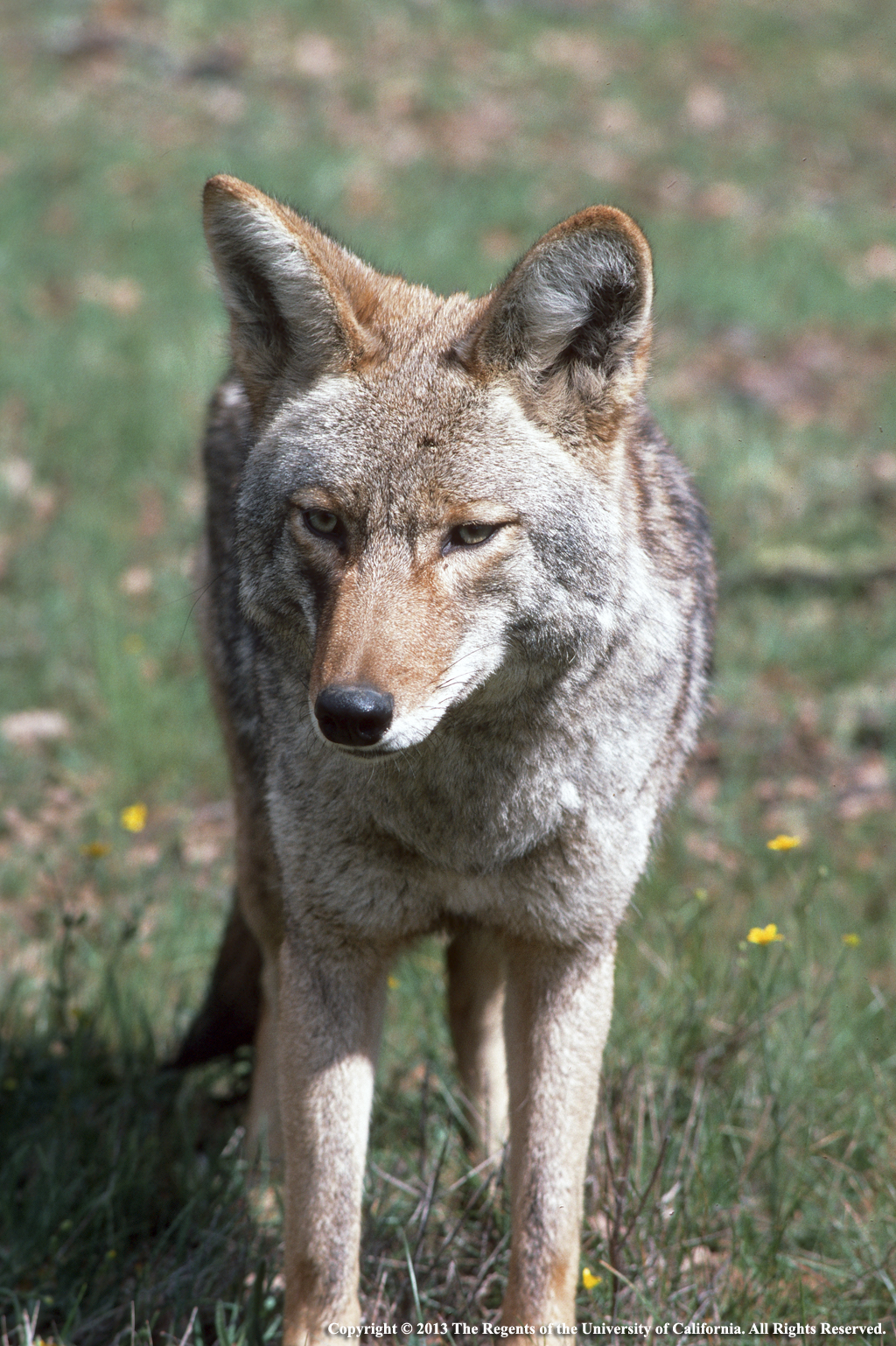
Wildlife species are well known for causing damage in nut orchards. Burrowing rodents such as ground squirrels, pocket gophers, and voles are the bane of many growers given the extensive damage they cause to trees, nuts, and irrigation infrastructure. Many bird species directly damage nut crops, and some can damage irrigation systems as well, but how about other terrestrial wildlife? Along riparian corridors and foothill regions, deer commonly damage young tree crops through browsing activities, rabbits cause extensive browsing and girdling damage in newly planted orchards, while coyotes chew on irrigation lines resulting in substantial damage in orchards. Management strategies vary substantially for these species with potential options highlighted in the following sections.
Deer
Mule deer and black-tailed deer (a subspecies of mule deer) are found in mountainous and riparian locations throughout orchard production areas in the western U.S. Deer regularly browse on younger trees, and bucks can sometimes damage trees when rubbing velvet off their antlers during late summer. Deer damage often occurs from dusk until dawn, so searching for deer signs is often needed to identify them as the culprit. This includes looking for hoof prints, fecal pellet groups, and signs of browsing; deer lack front incisors, and as such, browsing damage generally looks ragged from tearing rather than cleanly clipped off. Deer are considered a game species by wildlife management agencies. As such, management focuses primarily on exclusion and repellents.
Exclusionary fencing can be quite effective at reducing damage from deer. However, fencing is quite expensive. Generally, the whole orchard should be fenced to exclude deer. A common fence design involves the use of woven-wire mesh. Deer jump really well, so fencing is generally recommended to extend 8 feet above ground. If fencing is built on a slope, the fence may need to extend to 11 feet or more to keep deer from jumping over. Deer can also crawl under fencing, so it is important to make sure that the fence is flush with the ground. Electric fencing can also be used to keep deer out of smaller areas. Electric fencing is often a bit cheaper but may not be as effective, and care must be taken to ensure that the fencing does not short out. Many other designs for deer-proof fencing have been developed. I encourage anyone considering the use of exclusionary fencing for deer to check out the handbook, “Prevention and Control of Wildlife Damage, from the University of Nebraska, Lincoln available at digitalcommons.unl.edu/icwdmhandbook.
Repellents are also commonly used for deer, often relying on objectionable odors or unpleasant tastes to deter deer from browsing on treated trees. Many repellents have been developed and marketed for deer, and generally fall into “contact” and “area” categories. Contact repellents are those that require contact or ingestion of the product, while area repellents attempt to keep deer out of the general area. Efficacy of repellents varies substantially depending on a number of factors including availability of alternative food resources, abundance of rainfall (which can wash away some repellents), and how rapid new vegetative growth occurs. Products containing putrescent egg solids have often tested well, but other options are available. Many repellents are not suitable for use in food crops, so careful selection will be required to determine what is appropriate in your situation.
Lethal removal via shooting is a last resort for mitigating deer damage. Given their protected status as a game species, a depredation permit from your state wildlife agency will be required to lethally remove deer from your property. These are generally approved only after the landowner or agent has documented that all other non-lethal options were attempted and were unsuccessful.
Rabbits
Common examples of rabbit pests include black-tailed jackrabbits and desert cottontails. Jackrabbits technically are hares, and are quite a bit larger, have longer ears, and are generally a bigger pest in agricultural areas. Cottontails are smaller and are more common in landscaped areas. Common damage caused by rabbits includes girdling of newly planted trees and browsing on young vegetative growth. Rabbit browse damage is characteristically marked by a 45-degree cut on stems, while tooth marks from girdling damage are generally at a diagonal to the trunk. In many states, rabbits are classified as non-game species, although in California, they are classified as game species. Even so, they can generally be lethally removed from property by the landowner, tenant, or agent without any special permitting. Be sure to check your local restrictions before implementing lethal control.
As with deer, exclusion is a commonly used tool to minimize rabbit damage. Rabbit-proof fencing usually extends about 2½ to 3 feet above ground and is generally buried 6 inches below ground to keep rabbits from digging underneath the fence. Poultry fencing provides a good option. Rabbit fencing can be combined with deer-proof fencing to minimize their collective costs. Hard plastic or wire mesh tree protectors are sometimes used around the base of newly planted trees as well. They need to extend at least 2 feet above ground to eliminate browse and girdling damage.
Repellents are also effective against rabbits. As with deer, repellents can be “contact” or “area” in nature, and they are limited in utility in some settings (e.g., less effective when alternative foods are limited, must be periodically reapplied, etc.). Again, repellents that contain putrescent egg solids have often tested well. Keep in mind, repellents are usually not allowed for use on plants or parts that are to be eaten. They are most practical for rabbits when protecting young orchards that have yet to produce nuts.
Lethal control for rabbits is an option if alternative tools have been ineffective or impractical. Most states allow the use of traps or shooting to reduce rabbit numbers. Trapping is far more practical for cottontails. A variety of live and kill traps can be used. Jackrabbits are generally far too challenging to trap to consider it a viable option. Shooting can be used, although its utility is greatest when dealing with a small population of rabbits.
In California, a couple of toxicant baits containing either chlorophacinone or diphacinone can be used in self-dispensing bait stations to control jackrabbits and cottontails, although their use is only allowed along orchard field edges; use is not allowed within orchards. Please see the website for the Vertebrate Pest Control Research Advisory Committee for more information on this process at vprac.org.

Coyotes
Coyotes are quite common throughout the western U.S. The primary concern with coyotes is their proclivity to chew on irrigation lines. We do not know the primary driver for this chewing damage, but it is not water related. As such, providing supplemental water is not likely to solve the issue. Unfortunately, few options are effective. Wire mesh fencing can be used, but fencing must extend at least 5½ feet above ground and should be buried at least 6 inches below ground. Stays between wire meshing should be no more than 6 inches. Adding an electrified wire can increase the effectiveness of mesh fences. More detail on fence designs can be found in the UC IPM Coyote Pest Note at ipm.ucanr.edu/PMG/pestnotes.
Coyotes are considered a non-game animal. As such, they can be lethally removed through shooting and trapping. Regulations for coyote removal vary extensively across states, and even within states. As such, you should check with your local wildlife agency to determine what is allowed in your area.











